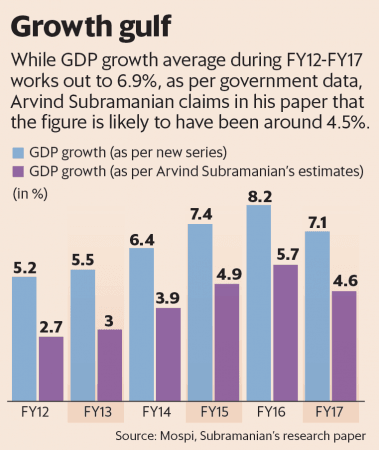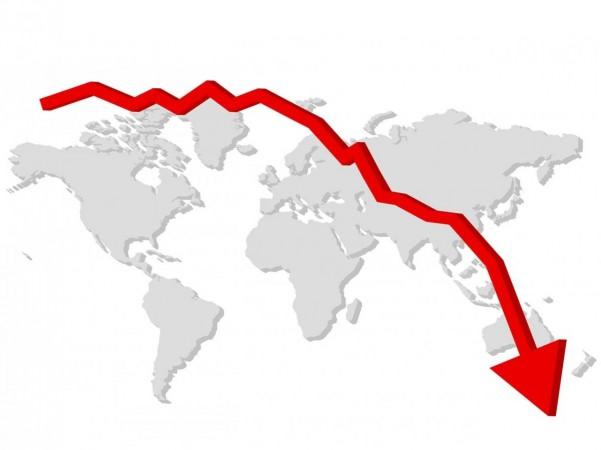With India's GDP growth rate on a decline for the past few years, it is of pertinence to understand if the figures stated by the Ministry of Statistics and Programme Implementation (MOSPI) under the Modi governance hold any verity to the projections made or if the numbers have been overestimated according to claims made by Former CEA Arvind Subramanian in the recent past.
Former chief economic adviser Arvind Subramanian published a research paper at Harvard University suggesting that, with the change in base year and calculation method, India's GDP could have been overestimated by a 2.5 percent every year since 2011. This put the cumulative GDP growth rate for 2011-18 at 19 to 21 percent. An overstatement claim coming from the former CEA of Modi Government from 2014 to 2018 of India's GDP growth rate by as high as 2.5 percent undoubtedly questions the authenticity of the growth numbers projected or presented.
The International Monetary Fund (IMF) has also raised doubts on India's GDP calculation methodology. Highlighting discrepancies between GDP by activity and GDP by expenditure complicate analysis, the IMF said, "There were weaknesses in the deflation method used to derive value added. Deflators are used to convert GDP at current prices to constant prices. The compilation of constant price GDP deviates from the conceptual requirements of the national accounts, in part due to the use of the Wholesale Price Index (WPI) as a deflator for many economic activities. The appropriate price to deflate GDP by type of activity is the Producer Price Index (PPI), which is under development."
How and when did the issue of discrepancy in GDP numbers all start?
It all started way back in 2004-05. India rebased its GDP statistics to base year 2011-12, which created a huge controversy that the Central Statistics Office (CSO) has shown the GDP growth rate 2 percentage points higher, to make India the fastest growing economy outpacing China.
Dating back to the past, the 1991 India's ICOR has not exceeded 4.5 percent. So, a GDP series that puts it at 5 during the UPA governance is highly questionable, especially when the total factor productivity (TFP) grew by an impressive 2.6% per year between 2003 to 2014. While it can be quite possible that the much underutilised capacity in 2014 is used for higher growth, thus leading to productivity boost.

Soon followed the rumble and disbelief from economic experts that the growth uptick as indicated is not matching the real numbers. But the issue was soon left in the backburner once again.
In 2018, the CSO under the guidance of NITI Aayog rebased the past GDP data series, and the GDP growth rate during 4 years tenure of the Modi governance was declared much higher than the days of UPA. In its defense, the CSO argued saying that it has not just rebased the GDP series but upgraded the GDP calculation methodology to meet UN National Accounting standards. After slicing and dicing, the approximations made to fix the database errors and make good of the GDP growth outlook of India, left some obvious inconsistencies and unanswered questions.
The rebased GDP data projection did not match any other economic numbers. Looking through profits and investment numbers, corporate sales, credit growth, direct tax revenue, exports and imports, the boom during UPA government as in comparison to the NDA times, is made to be reflective of a faster growing economy.
Probing deeper into the GDP misestimation numbers
The entire issue later came to surface once again post release of a report by the National Statistical Commission (NSC) in 2018 that showed double-digit growth rate during the UPA years. The centre later backed up the GDP data series showing lower GDP growth rate under the UPA government.
Debunking the overstatement claims made by Arvind Subramanian, the Economic Survey 2019-20 presented by Chief Economic Adviser Krishnamurthy Subramanian in the Parliament said, "As concerns about the veracity of India's GDP growth rates may generate substantial concerns not only to investors but also to policymakers, this issue warrants a careful examination."

The Economic Survey emphasised that, "The models that incorrectly overestimate GDP growth by over 2.77 per cent for India post-2011 also misestimate GDP growth over the same time period for 51 other countries by anywhere between +4 per cent to -4.6 percent. However when the models are estimated correctly by accounting for all unobserved differences among countries as well as the differential trends in GDP growth across countries, GDP growth for most of these 52 countries is neither over- or under-estimated. In sum, concerns of overestimation of India's GDP are unfounded."
The survey concluded saying that, "by comparing the Indian GDP growth rates to those of other countries" using the same methodology, "no evidence of misestimation of India's GDP growth is found". It further pegged the GDP growth rate of India for 2020-21 at 6 to 6.5 per cent. But all India ratings of the Fitch Group, the IMF and the World Bank all predict a lower GDP growth rate between 5 to 6 percent only.
Quite a few noteworthy observations were derived, looking at the GDP numbers from the past to the present, and for the near future:
- It's interesting to note that the GDP growth rate calculated as per the new methodology is higher in 2011-12, indicated as the base year, and every year after that, but it is lower in every year prior to that in the rebased series, drawing comparison with the old series. The GDP growth rate shown under the old series after 2011-12 is readily available, which is quite an eyebrow raiser.
- Further, there is not a big difference between nominal data and the GDP data, suggesting that there is something wrong with the deflators.
- Also the differences in growth rates are mainly in the tertiary sector and not so much in the manufacturing and agriculture sector. The growth rates in the services sector lower every year after 2005-06. This leaves us with questions on assumptions made, to arrive at this discrepancy in consequent years.
Impact of Covid-19 outbreak on the Indian economy: Challenges and setbacks
In a report by KPMG titled, 'Potential Impact of Covid-19 on the Indian economy,' Arun M. Kumar, Chairman and CEO, KPMG in India says that, "The course of economic recovery in India will be much smoother and faster than that of many other advanced countries."
The UNCTAD in its latest report 'The COVID-19 shock to Developing Countries' has also predicted that major economies least exposed to recession would be China and India. With the Covid-19 outbreak and 21-days nationwide lockdown disrupting the global supply chain, the three major contributors to GDP growth have been hugely affected - the private consumption, investment and external trade.

Scenario 1: In case of quick retraction by global markets including India by end of April or May 15, the report claims, India to hold high hopes of solid recovery with an estimated GDP growth rate of 5.3 to 5.7 percent in 2020-21.
Scenario 2: In case India controls spread of the coronavirus pandemic, amidst global recession, the KPMG report projects that in this scenario, "The impact on India's growth in terms of global spillovers will be meaningful, owing to India's integration with the global economy. So India's growth will be lower than scenario 1: the expected range will be 4 to 4.5 per cent."
Scenario 3: In case the Covid-19 proliferates further and the lockdown gets extended then, it projects, "A double whammy for the economy, as it will have to bear the brunt of both domestic and global demand destruction. Prolonged lockdowns would exacerbate economic troubles. India's growth may fall below 3 percent." On what basis are these projections made?

Meanwhile, the Indian Government has not passed on the fall in international crude prices to consumers but instead used this development to improve its fiscal position. Are businesses and economies prepared to embrace the new Covid-19 normal world, calling for measured, practical and informed approaches?
Call for Action
While we are not pointing out to the government nor blaming any political overtones responsible for the overestimation. It is time we hold a more realistic view of the economic growth rather than strong narratives of gun-blazing India. We should compare the old and the new GDP data series, while sticking to simplistic GDP calculation models and arrive at accurate projections, perhaps in line with the Ministry of statistics estimates.
It is equally important to understand that diverse economies such as India will take time to evolve to the UN-adopted System of National Accounts. Here's calling out a need to revisit the GDP numbers as a serious one. We hold high hopes from the government to take quick remedial measures to study, analyse and fix the data mishap.
In light of the GDP number jumble and controversies established, it is required of the government to establish an independent panel to review the GDP calculation methodology and study the numbers released by MOSPI in public interest.

















